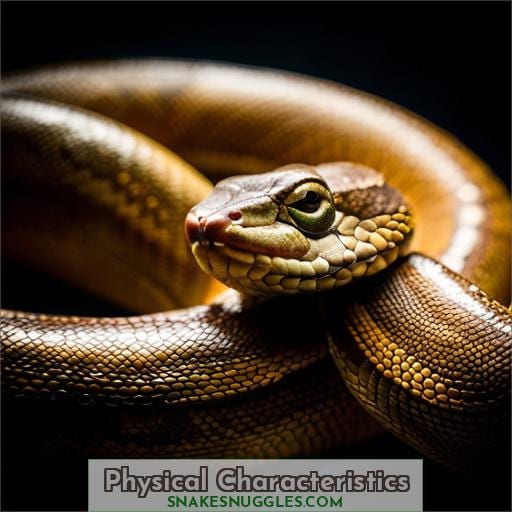This site is supported by our readers. We may earn a commission, at no cost to you, if you purchase through links.

You seek the crucial differences between ribbon snakes and garter snakes? Prepare for nature’s striking divergence!
In appearance, ribbon snakes possess lean bodies and elongated tails, while garter snakes exhibit sturdy frames with shorter stripes.
Their habitats diverge as well – ribbon snakes flourish in wetlands, while garter snakes favor forests and grasslands.
Geographically, ribbon snakes reside in the southeastern United States, whereas garter snakes range from Maine to Florida.
Although both fulfill essential ecological functions, their conservation statuses vary, with garter snakes encountering challenges.
Exploring their intriguing distinctions will illuminate nature’s remarkable diversity. Curious? Allow me to delve further into this captivating subject.
Table Of Contents
Key Takeaways
- Ribbon snakes have lean bodies and elongated tails, making up about a third of their total length, while garter snakes have more robust body shapes with shorter tails.
- Ribbon snakes prefer wetlands and waterbodies for their habitat, thriving in these environments by feeding on cold-blooded prey like frogs and small fish. In contrast, garter snakes are more versatile, inhabiting forests, grasslands, and a variety of other environments, with a diet that includes amphibians, earthworms, mice, and nestling birds.
- Geographically, ribbon snakes are primarily found in the southeastern United States, focusing on wetlands and the edges of ponds and streams. Garter snakes have a broader range, extending from Maine to central Missouri and from central Ontario to Florida, showcasing their adaptability to different habitats.
- Both species play crucial roles in their ecosystems by providing pest control, but they face different conservation challenges. Garter snakes, in particular, are listed as Threatened in some areas due to habitat degradation, persecution, and climate change, highlighting the need for conservation efforts to protect these species.
Physical Characteristics
When you’re out and about in nature, keep your eyes peeled for the slinky silhouettes of garter and ribbon snakes. These serpentine siblings share some traits, but don’t be fooled; they’re as different as chalk and cheese.
Garter snakes flaunt a more robust body shape and shorter stripe length. Ribbon snakes are the runway models of the reptile world with their slender bodies and long tails that make up about a third of their total length.
The garter’s coloration is a mixtape of greens, browns, or blacks, jazzed up with yellow stripes. Meanwhile, ribbon snakes sport a chic white mark near their eyes, adding a touch of mystery to their variable ground snake vibe.
Keep an eye out for these details, and you’ll be distinguishing these creatures like a pro.
Habitat
the Eastern Garter Snake and the Eastern Ribbon Snake.
The Eastern Garter Snake, a native of Massachusetts, is a versatile creature that thrives in a variety of habitats. From deciduous forests to grasslands, swamps, and fields, this snake has a knack for adapting to its surroundings. Its diet is as diverse as its habitat, with a menu that includes amphibians, earthworms, mice, and nestling birds.
On the other hand, the Eastern Ribbon Snake, also found in Massachusetts, is a more specialized creature. It prefers wetlands and waterbodies, where it can hunt its prey with ease. Its habitat is more specific, but it’s no less fascinating.
Both species have their unique ways of dealing with predators and prey. While the Garter Snake is known to be shy and non-aggressive, the Ribbon Snake is more elusive and slender, making it a formidable predator. During hibernation, these snakes seek out suitable dens, often in wooded areas, to weather the harsh winter months.
Distribution
The distribution of garter snakes and ribbon snakes in Massachusetts is quite similar, with both species found in the state. However, there are some key differences in their geographic ranges.
- Range Overlap: Garter snakes have a broader range that extends from Maine to central Missouri and from central Ontario to Florida. In contrast, ribbon snakes are found in the southeastern United States, typically in wetlands and near the edges of ponds and streams.
- Regional Distribution: Eastern garter snakes are native to Massachusetts, while eastern ribbon snakes also inhabit the state.
- Population Density: The distribution of garter snakes and ribbon snakes can vary depending on factors such as habitat availability and prey abundance. For example, garter snakes are found in a wide variety of habitats, from dry to wet, whereas ribbon snakes are usually found in and near shallow water.
- Species Distribution: The distribution of garter snakes and ribbon snakes can also be influenced by their feeding habits. Garter snakes feed on a variety of small animals, including amphibians, earthworms, mice, and nestling birds. Ribbon snakes, on the other hand, primarily prey on amphibians, mainly frogs, as well as small fish and insects.
Understanding the distribution of these two species is critical for conservation efforts and for minimizing human-snake interactions.
Importance
Snakes play a critical role in their ecosystems, providing pest control and exhibiting diverse characteristics. In Massachusetts, both garter snakes and ribbon snakes are found, with garter snakes being more common and widely distributed. They’re non-venomous and provide pest control, making them important members of the ecosystem. However, they can also be found in homes and outbuildings in search of food. To prevent snakes from entering buildings, it’s necessary to seal cracks in the foundation and cover basement windows with screens.
Garter snakes and ribbon snakes have different feeding habits and life cycles. Garter snakes feed on a variety of small animals, including amphibians, earthworms, mice, and nestling birds. They mate in March or April, with females being viviparous and giving birth to young in July or October. Ribbon snakes, on the other hand, are found in wetlands and waterbodies and feed on cold-blooded prey items such as frogs, lizards, tadpoles, fish, earthworms, and crickets. They’re also known for their intelligence and can be handled without fear of biting.
In Texas, 29 species of snakes are found, each with its distinct characteristics and behavior. Understanding these differences can help reduce fear and increase respect for these creatures. It’s essential to observe snakes from a safe distance, as handling can harm both the snake and the human. Venomous snakes in Texas include the western massasauga rattlesnake, midget faded rattlesnake, and prairie rattlesnake.
Conservation Status
Snakes in Massachusetts: Conservation Status
As we delve deeper into the captivating realm of snakes in Massachusetts, it’s imperative to address the conservation standing of these creatures. The three species classified as Endangered are the Eastern Massasauga Rattlesnake, the Eastern Hog-nosed Snake, and the Eastern Smooth Earthsnake. One species, the Eastern Garter Snake, is listed as Threatened. These species face challenges from habitat degradation, persecution, and climate change.
Habitat loss poses a dire threat to these snakes. As human populations expand and cities grow, natural habitats are often destroyed or broken into pieces, hindering the survival of snakes. Furthermore, climate change can shift the distribution and abundance of prey species, further affecting snake populations.
Persecution remains a significant menace. Many individuals harbor fear or misconceptions about snakes, leading to their persecution. This can result in snakes being killed or banished from their habitats, further diminishing their numbers.
Conservation measures are vital to safeguard these species. This includes restoring and preserving habitats, educating the public to dispel fear and misconceptions about snakes, and enacting laws and regulations to protect endangered and threatened species.
Grasping the conservation status of these snakes is paramount for their survival. By acknowledging the threats they confront and taking steps to protect them, we can guarantee that these intriguing creatures continue to flourish in Massachusetts for generations to come.
Frequently Asked Questions (FAQs)
How do ribbon and garter snakes reproduce?
You’re curious about how these snakes reproduce? Well, both garter and ribbon snakes give birth to live young, rather than laying eggs. The females mate in spring after emerging from hibernation, then gestate the babies through summer before birthing them in late summer or early fall.
What are common predators of these snakes?
Don’t worry, these harmless backyard buddies face threats too – birds, mammals, even other snakes may prey on them if not careful. But you can help by providing cover and leaving them be when spotted. After all, they’re excellent pest control!
Can ribbon and garter snakes coexist in the same habitat?
Sure, ribbon and garter snakes can absolutely coexist in the same habitat. They’ve adapted to live side-by-side in wetlands and forests across many regions. While similar, their slight differences in diet and microhabitat preferences allow them to share space harmoniously.
How do seasonal changes affect these snakes’ behavior?
You’ll notice these snakes become less active as winter approaches – they’re preparing to brumate (similar to hibernation). Come spring, their increased movements signal mating season is here! Witnessing their fascinating life cycles connects you to nature’s rhythms.
What are the challenges in captive breeding of these species?
Captive breeding of garter and ribbon snakes can be challenging – you’ll need the appropriate environment, diet, and patience. Establishing ideal temperature, humidity, and hiding spots is essential for successful reproduction. But with some experience, you can build a flourishing captive population.
Conclusion
Similar to unearthing precious jewels, comprehending the 5 primary distinctions between ribbon snakes and garter snakes illuminates our admiration for nature’s intricate fabric. You have embarked on an enchanting journey where these serpentine species display contrasting physical characteristics, dwelling places, geographic ranges, environmental functions, and preservation dilemmas. Embrace this wisdom, treasuring the marvel that serpentine variety bestows upon our planet.











